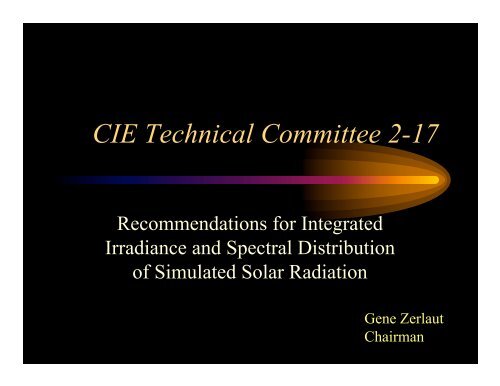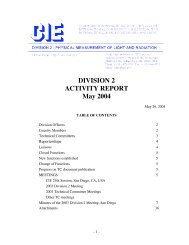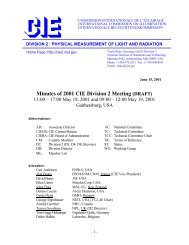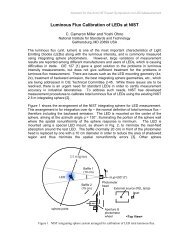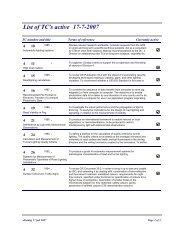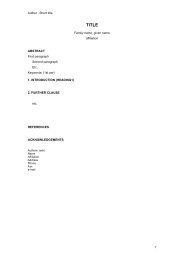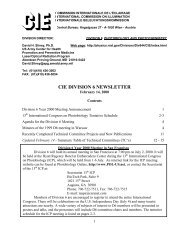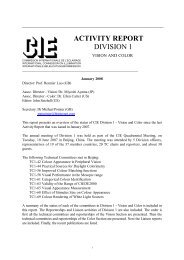PDF (100 KB) - cie
PDF (100 KB) - cie
PDF (100 KB) - cie
- No tags were found...
You also want an ePaper? Increase the reach of your titles
YUMPU automatically turns print PDFs into web optimized ePapers that Google loves.
CIE Technical Committee 2-17Recommendations for IntegratedIrradiance and Spectral Distributionof Simulated Solar RadiationGene ZerlautChairman
Solar Radiation Models - I• BRITE Code - a Monte Carlo method of multiple, successive iterations(basis of ASTM E 891, E 892 & G 159 (all withdrawn or beingwithdrawn). Blättner et al, Bird et al (NREL)• Line and Band Models– HITRAN - High Resolution Line Model accessed by FASCODE– MODTRAN - Moderate Resolution band model developed byAFOSR (0.l02 nm resolution at 300 nm to 3 nm at 4000 nm)– LOWTRAN - Low resolution band model (AFOSR)• Parameterization Models– SPECTRAL2 (Richard Bird, NREL)– SMARTS2 (Dr. Christian Gueymard) - Basis of ASTM G 173. Beingplaced into ISO TC 180 (Solar Energy) and IEC TC 85 (Photovoltaics) -Validated by spectroradiometric field measurements.
Solar Radiation Models - II• Model used in CIE Publication No. 85 (origin notwell documented)• Other Models– VDI (Verein Deutscher Ingenieure) Calculation of SunRadiation - Status unknown.– STAR (System for Transfer of Atmospheric Radiation)University of Tokyo and University of Munichcollaboration. Status unknown.
CIE Publication No. 85• Global Solar Irradiance agrees reasonably wellwith ASTM G173 (and with ASTM E892 andG159 - both of which have been withdrawn)• Cannot be validated because the radiation code onwhich it is based is not readily available• Deviates from SMARTS2 (and MODTRAN) in500 - 700-nm region
Proposed Approach - Task I• Re-compute Publication No. 85 on the basis of theSMARTS2 solar radiation code developed by Dr.Christian Gueymard– Re-compute using the atmospheric, geographical andgeometric input parameters used to computePublication No. 85– Re-issue Publication No. 85 under the rules establishedby CIE for such revisions
Proposed Approach - Task II• Using the SMARTS2 radiation code, computeapplication-based reference spectra that thecommunity of solar radiation and relatedtechnologies deem to be needed, or useful - e.g.,– building energy technologies for different climates(e.g., solar loading)– daylighting technologies– fenestration energy considerations– UV radiometer calibrations using reference spectra
Proposed Approach - Task III• Continue the task begun in Part II of PublicationNo. 85 to construct tables to guide efforts tosimulate solar radiation for various applications:– Completing Part II based on the SMARTS2 version ofPublication No. 85– Initiate activities to construct tables as guides forsimulation of solar radiation applications identified inTask II• It will be necessary to prioritize such work based onboth need and the availability of experts


